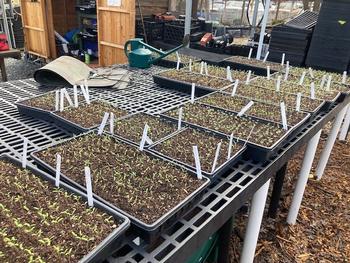The Latest Dirt - March 2024
Seed Viability for Seed Savers
By Simone Adair

National seed banks monitor their supply constantly; Fowler says, “When they see that a seed sample is declining in its viability, they will take some seeds out, grow them in the real world, and multiply them.”
For the home gardener, seed viability starts with where you get your seeds. According to the California Department of Food and Agriculture, “Poor quality seeds can cost farmers and home gardeners alike considerable amounts of time, money, and resources, by way of reduced yields, poor crop quality, contamination by weeds or other unwanted species.”

Our Garden Project Lead, Janet Miller, said, “I use 25 different vendors for the Garden and the Great Tomato Plant Sale. Reputable seed companies are so important.” She looks for seeds that are 100% organic and vendors that test for disease and germination rates.
For Miller, this is essential. “I really need a reliable germination rate. For people at home, there’s a test you can do. Put a few seeds in a damp paper towel inside a zip-lock bag. It’s an easy way to germinate seeds.” The test result also determines the seed germination rate as a percentage. Use this calculation to determine seed germination rate:
(Number of seeds sprouted X 100) / Total number of seeds tested = Germination rate%
Example: (17 seeds sprouted X 100) / 20 seeds tested = 85% germination rate

And just like the Svalbard Seed Vault, how you store your seed is essential. According to Illinois Extension University of Illinois Urbana Champaign, “Seeds need to be kept dry and cool. The most important factors in seed storage are seed moisture and storage temperature. The drier the seeds at time of storage, the longer they can be stored. Store in low humidity and low temperature, below 45°F (15 °C). Storing in a sealed container, such as a jar or bag, in a refrigerator is recommended. If you do not have room in a refrigerator, just keep the seeds cool and dry.” A simple rule of thumb is that the sum of the temperature (degrees F) and percent relative humidity should be less than 100.
Of course, some seeds like lambsquarters seem to be viable for decades. Even more amazing, though, is a marble-size lotus seed that lay dormant in a Manchurian dry lakebed for over 12 centuries is the oldest living seed ever germinated and could shed new light on the aging process, UCLA scientists said.

Shen-Miller was given seven of the ancient lotus seeds in 1982 by the Beijing Institute of Botany. Curious about their viability, she attempted to germinate four of them in 1983, getting three to sprout in the usual four-day germination period. She then had the sprouts carbon dated, a process that killed the plants. But to Shen-Miller's astonishment, the process revealed that they were 1,288 and 684 years old.
